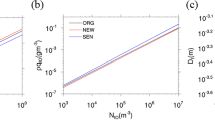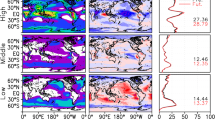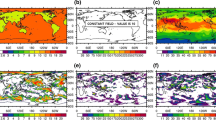Abstract
A new cloud microphysics scheme including a prognostic treatment of cloud ice (PCI) is developed to yield a more physically based representation of the components of the atmospheric moisture budget in the general circulation model ECHAM. The new approach considers cloud water and cloud ice as separate prognostic variables. The precipitation formation scheme for warm clouds distinguishes between maritime and continental clouds by considering the cloud droplet number concentration, in addition to the liquid water content. Based on several observational data sets, the cloud droplet number concentration is derived from the sulfate aerosol mass concentration as given from the sulfur cycle simulated by ECHAM. Results obtained with the new scheme are compared to satellite observations and in situ measurements of cloud physical and radiative properties. In general, the standard model ECHAM4 and also PCI capture the overall features, and the simulated results usually lie within the range of observed uncertainty. As compared to ECHAM4, only slight improvements are achieved with the new scheme. For example, the overestimated liquid water path and total cloud cover over convectively active regions are reduced in PCI. On the other hand, some shortcomings of the standard model such as underestimated shortwave cloud forcing over the extratropical oceans of the respective summer hemisphere are more pronounced in PCI.
Similar content being viewed by others
References
Albrecht BA (1989) Aerosols, cloud microphysics, and fractional cloudiness. Science 245:1227–1230
Arakawa A (1975) Modelling clouds and cloud processes for use in climate models. GARP Publication Series 16. ICSU/WMO:183–197
Beheng KD (1994) A parametrization of warm cloud microphysical conversion processes. Atmos Res 33:193–206
Berry EX, Reinhardt RL (1973) Modeling of condensation and collection within clouds. DRI Phys Sci Pub 16, University of Nevada
Bigg EK (1953) The supercooling of water. Proc Phys Soc 66:688–694
Boer GJ, McFarlane NA, Laprise R, Henderson JD, Blanchet JP (1984) The Canadian Climate Centre spectral atmospheric general circulation model. Atmosphere-Ocean 22:397–429
Boucher O, Lohmann U (1995) The sulfate-CCN-cloud albedo effect. A sensitivity study with two general circulation models. Tellus 47B:281–300
Boucher O, Le Trent H, Baker MB (1995) Precipitation and radiation modelling in a GCM: introduction of cloud microphysical processes. J Geophys Res 100:16395–16414
Brinkop S, Roeckner E (1995) Sensitivity of a general circulation model to parametrizations of cloud-turbulence interactions in the atmospheric boundary layer. Tellus 47A:197–220
Calahan RF, Ridgway W, Wiscombe WJ, Bell TL, Snider JB (1994) The albedo of fractal stratocumulus clouds. J Atmos Sci 51:2434–2455
Cess RD, Potter GL, Blanchet JP, Boer GJ, Del Genio AD, Déqué M, Dymnikov V, Galin V, Gates WL, Ghan SJ, Kiehl JT, Lacis AA, Le Treut H, Li ZX, Liang XZ, McAvaney BJ, Meleshko VP, Mitchell JFB, Morcrette JJ, Randall DA, Rikus L, Roeckner E, Royer JF, Schlese U, Sheinin DA, Slingo A, Sokolov AP, Taylor KE, Washington MW, Wetherald RT, Yanai I, Zhang MH (1990) Intercomparison and interpretation of climate feedback processes in 19 atmospheric general circulation models. J Geophys Res 95:16601–16615
Chen C, Cotton WR (1987) The physics of the marine stratocumulus-capped mixed layer. J Atmos Sci 44:2951–2977
Chen CT, Roeckner E (1996) Validation of the Earth radiation budget as simulated by the Max Planck Institute for Meteorology general circulation model ECHAM4 using satellite observations of the Earth Radiation Budget Experiment (ERBE). J Geophys Res 101:4269–4287
Claussen M, Lohmann U, Roeckner E, Schulzweida U (1994) A global data set of land-surface parameters. Report 135, Max-Planck-Institut für Meteorologie, Germany
Collins WD, Conant WC, Ramanathan V (1994) Earth radiation budget, clouds and climate sensitivity. In: Calver JG (ed) The chemistry of the atmosphere: its impact on global change. Oxford University Press, Oxford, UK, pp 207–215
Cotton WR, Tripoli GJ, Rauber RM, Mulvihill EA (1986) Numerical simulation of the effects of varying ice crystal nucleation rates and aggregation processes on orographic snowfall. J Climate Appl Meteorol 25:1658–1680
Davis A, Gabriel P, Lovejoy S, Schertzer D, Austin GL (1990) Discrete angle radiative transfer: 3. Numerical results and meterological applications. J Geophys Res 95:11729–11742
Del Genio AD, Yao MS, Kovari W, Lo KKW (1996) A prognostic cloud water parametrization for global climate models. J Climate 9:270–304
Eppel DP, Kapitza H, Claussen M, Jacob D, Koch W, Levkov L, Mengelkamp HT, Werrmann N (1995) The non-hydrostatic mesoscale model GESIMA. Part II: parametrizations and applications. Beitr Phys Atmos 68:15–41
Feichter J, Kjellstrom E, Rodhe H, Dentener F, Lelieveld J, Roelofs GJ (1996) Simulation of the tropospheric sulfur cycle in a global climate model. Atmos Environ (in press)
Fouquart Y, Bonnel B (1980) Computations of solar heating of the Earth's atmosphere: a new parameterization. Beitr Phys Atmos 53:35–62
Fouquart Y, Isaka H (1992) Sulfur emission, CCN, clouds and climate: a review. Ann Geophys 10:462–471
Fowler LD, Randall DA, Rutledge SA (1996) Liquid and ice cloud microphysics in the CSU general circulation model. Part I: model description and simulated microphysical processes. J Climate 9:489–529
Gates WL (1992) AMIP: the atmospheric model intercomparison project. Bull Am Meteorol Soc 73:1962–1970
Geleyn JF (1981) Some diagnostics of the cloud radiation interaction on ECMWF forecasting model. In: Workshop on radiation and cloud-radiation interaction in numerical modelling. 15–17 Oct. 1980 ECMWF, Reading, UK, pp 135–162
Ghan SJ, Easter RC (1992) Computationally efficient approximations to stratiform cloud microphysics parametrization. Mon Weather Rev 120:1572–1582
Greenwald TJ, Stephens GL, Vonder Haar TH, Jackson DL (1993) A physical retrieval of cloud liquid water over the global oceans using Special Sensor Microwave/Imager (SSM/I) observations. J Geophys Res 98:18471–18488
Gunn KLS, Marshall JS (1958) The distribution with size of aggregate snowflakes. J Meteor 15:452–461
Hahn CJ, Warren SG, London J (1994) Climatological data for clouds over the globe from surface observations, 1982–1991: the total cloud edition ORNL/CDIAC-72 NDP-026A Oak Ridge National Laboratory Oak Ridge, Tennessee, USA
Hegg DA, Hobbs PV, Ferek RJ, Waggoner AP (1995) Measurements of some aerosol properties relevant to radiative forcing on the east coast of the United States. J Appl Meteorol 34:2306–2315
IPCC, Climate Change (1992) The supplementary report to the IPCC scientific assessment. In: Houghton JT, Callander BA, Varney SK (eds), Cambridge University Press, Cambridge, UK
Johnson DW (1993) Parametrisation of the cloud topped boundary layer. Aircraft measurements. In: ECMWF Workshop Proc ‘Parametrization of the cloud topped boundary layer’, ECMWF, Reading, UK, pp 77–117
Kessler E (1969) On the distribution and continuity of water substance in atmospheric circulations, Meteorol Monogr 32, Am Meteorol Soc
Kiehl JT, Hack JJ, Briegleb BP (1994) The simulated Earth radiation budget of the National Center for Atmospheric Research community climate model CCM2 and comparisons with the Earth Radiation Budget Experiment (ERBE). J Geophys Res 99:20815–20827
King MD, Radke LF, Hobbs PV (1993) Optical properties of marine stratocumulus clouds modified by ships. J Geophys Res 98:2729–2739
Lee JL, Liou KN, Ou SC (1992) A three-dimensional large-scale cloud model: testing the role of radiative heating and ice phase processes. Tellus 44A:197–216
Le Trent H, Li ZX (1988) Using Meteosat data to validate a prognostic cloud generation scheme. Atmos Res 21:273–292
Levkov L, Rockel B, Kapitza H, Raschke E (1992) 3D mesoscale numerical studies of cirrus and stratus clouds by their time and space evolution. Beitr Phys Atmos 65:35–58
Lin YL, Farley RD, Orville HD (1983) Bulk parametrization of the snow field in a cloud model. J Clim Appl Meteorol 22:1065–1092
Lohmann U, Roeckner E, Collins WD, Heymsfield AJ, McFarquhar GM, Barnett TP (1995) The role of water vapor and convection during the Central Equatorial Pacific Experiment (CEPEX) from observations and model simulations. J Geophys Res 100:26229–26245
Lord SJ, Willoughby HE, Piotrowicz JM (1984) Role of parametrized ice-phase microphysics in an axialsymmetric, nonhydrostatic tropical cyclone model. J Atmos Sci 41:2836–2848
Malm WC, Sisler JF, Huffman D, Eldred RA, Cahill TA (1994) Spatial and seasonal trends in particle concentration and optical extinction in the United States. J Geophys Res 99:1347–1370
Manabe S, Smagorinsky J, Strickler RF (1965) Simulated climatology of a general circulation model with a hydrological cycle. Mon Weather Rev 93:769–798
Mason BJ (1971) The physics of clouds. Clarendon Press, Oxford
Matveev LT (1984) Cloud dynamics. Atm Sci Library, Reidel, Dordrecht
McFarlane NA, Boer GJ, Blanchet JP, Lazare M (1992) The Canadian Climate Centre second-generation general circulation model and its equilibrium climate. J Climate: 1013–1044
McFarquhar GM, Heymsfield AJ (1996) Microphysical characteristics of three anvils sampled during the Central Equatorial Pacific Experiment (CLEPEX). J Atmos (in press)
Mölders N, Laube M, Kramm G (1994) A scheme for parametrizing ice and water clouds in regional models. Proc of EUROTRAC Symp 1994, Borrell et al. (eds), SPB Academic Publishing, The Hague, The Netherlands, pp 839–844
Morcrette JJ (1991) Radiation and cloud radiative properties in the European Centre for Medium Range Weather Forecasts forecasting system. J Geophys Res 96:9121–9132
Murakami M (1990) Numerical modeling of dynamical and microphysical evolution of an isolated convective cloud — The 19 July 1981 CCOPE cloud. J Meteorol Soc Japan 68:107–128
Nordeng TE (1994) Extended versions of the convective parameterization scheme at ECMWF and their impact on the mean and transient activity of the model in the tropics. Tech Memo 206, 41 pp, Euro Cent for Medium Range Weather Forecasts, Reading, England
Novakov T, Penner JE (1993) Large contribution of organic aerosols to cloud-condensation-nuclei concentrations. Nature 365:823–826
Ose T (1993) An examination of the effects of explicit cloud water in the UCLA GCM. J Meteorol Soc Japan 71:93–109
Potter BE (1991) Improvements to a commonly used cloud microphysical bulk parametrization. J Appl Meteorol 30:1040–1042
Pruppacher HR, Klett JD (1978) Microphysics of clouds and precipitation. Reidel, Dordrecht
Radke LF, Coagley JA Jr, MD King (1989) Direct and remote sensing observations of the effects of ships on clouds. Science 246:1146–1149
Ramanathan V, Cess RD, Harrison EF, Minnis P, Barkstrom BR, Ahmad E, Hartmann D (1989) Cloud-radiative forcing and climate: results from the Earth Radiation Budget Experiment. Science 243:57–63
Rangno AL, Hobbs PV (1994) Ice particle concentrations and precipitation development in small continental cumuliform clouds. Q J R Meteorol Soc 120:573–601
Rasch PJ, Williamson DL (1990) Computational aspects of moisture transport in global models of the atmosphere. Q J R Meteorol Soc 116:1071–1090
Rockel B, Raschke E, Weyres B (1991) A parametrization of broad-band radiative transfer properties of water, ice and mixed clouds. Beitr Phys Atmos 64:1–12
Roeckner E (1995) Parameterization of cloud radiative properties in the ECHAM4 model. In: WCRP Workshop “Cloud microphysics parametrizations in global atmospheric circulation models”, 23–25 May 1995, WCRP-90, Kananaskis, Canada, pp 105–116
Roeckner E, Schlese U (1985) January simulation of clouds with a prognostic cloud cover scheme. In: ECMWF Workshop “Cloud cover parametrization in numerical models”, 26–28 Nov. 1984, ECMWF, Reading, UK, pp 87–108
Roeckner E, Arpe K, Bengtsson L, Brinkop S, Dümenil L, Esch M, Kirk E, Lunkeit F, Ponater M, Rockel B, Sausen R, Schlese U, Schubert S, Windelband M (1992) Simulation of the present-day climate with the ECHAM model: impact of model physics and resolution. Report 93, Max-Planck-Institut für Meteorologic, Germany
Rossow WB, Schiffer RA (1991) ISCCP cloud data products. Bull Am Meteorol Soc 72:2–20
Rossow WB, Walker AW, Garder LC (1993) Comparison of ISCCP and other cloud amounts. J Climate 6:2394–2418
Rutledge SA, Hobbs PV (1983) The mesoscale and microscale structure and organization of clouds and precipitation in midlatitude cyclones. VII: a model for the “Seeder Feeder” process in warm-frontal bands. J Atmos Sci 40:1185–1206
Slingo JM (1987) The development and verification of a cloud prediction scheme for the ECMWF model. Q J R Meteorol Soc 113:899–927
Smagorinsky J (1960) On the dynamical prediction of large-scale condensation by numerical methods. In: Physics of Precipitation, Geophys Mono 5, Am Geophys Union:71–78
Smith RNB (1990) A scheme for predicting layer clouds and their water content in a general circulation model. Q J R Meteorol Soc 116:435–460
Sundqvist H (1978) A parametrization scheme for non-convective condensation including prediction of cloud water content. Q J R Meteorol Soc 104:677–690
Sundqvist H, Berge E, Kristjansson JE (1989) Condensation and cloud parametrization studies with a mesoscale numerical weather prediction model. Mon Weather Rev 117:1641–1657
Tiedtke M (1989) A comprehensive mass flux scheme for cumulus parametrization in large-scale models. Mon Weather Rev 117:1779–1800
Warneck P (1988) Chemistry of the natural atmosphere. Int Geophys Series 41, Academic Press, San Diego, USA
Weng F, Grody NC (1994) Retrieval of cloud liquid water using the special sensor microwave imager (SSM/I). J Geophys Res 99:25535–25551
Xu KM, Krueger SK (1991) Evaluation of cloudiness parametrizations using a cumulus ensemble model. Mon Weather Rev 119:342–367
Young KC (1993) Microphysical processes in clouds. Oxford University Press, New York
Author information
Authors and Affiliations
Rights and permissions
About this article
Cite this article
Lohmann, U., Roeckner, E. Design and performance of a new cloud microphysics scheme developed for the ECHAM general circulation model. Climate Dynamics 12, 557–572 (1996). https://doi.org/10.1007/BF00207939
Received:
Accepted:
Issue Date:
DOI: https://doi.org/10.1007/BF00207939




